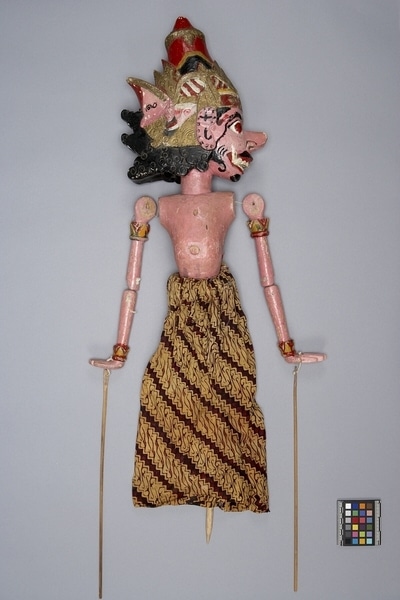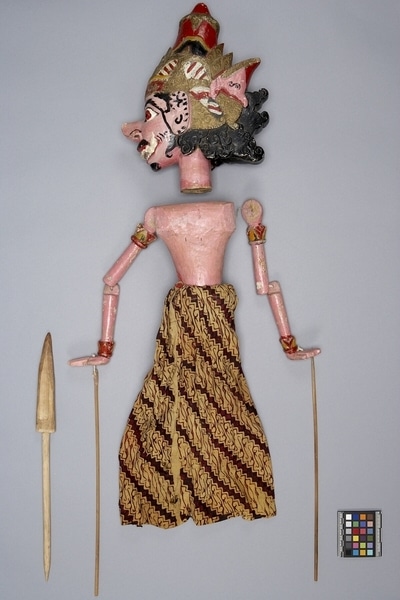Rod Puppet Item Number: Ib348 a-d from the MOA: University of British Columbia


Description
Three-dimensional male humanoid puppet: large head (part b) fits into body with skirt (part a), and a control rod (part d) with a long shaft that passes through the body and fits into the neck of the figure's head. The body has jointed arms, and the figure's right arm (part c) is detached. Each arm has a long controlling rod attached. Pink face positioned forward; bulging eyes with red irises, large wedge-shaped nose, wide red lips and prominent upper teeth. Fangs extend from top and bottom row at each side of mouth. Long hair, eyebrows, sideburns, moustache and beard painted in black. Crown (mahkota) with diadem (jamang), karawista, ear ornaments (sumping) and Garuda Mungkur; in gold, red, pink, white, black, yellow. Upper torso pink, uncovered; wide shoulders, prominent belly. Red, yellow ornaments on upper arms and at wrists. Left arm detached; hands held flat and bent back at wrist. Long batik skirt (kain) in yellow-brown, red and black.
History Of Use
Javanese puppetry as an art form probably developed by the 11th century. Wayang golek puppets of western Java appeared during the 16th century. Originally the plays depicted Javanese mythology, but after the Indian conquest of Java the Hindu epics, Ramayana and Mahabharata, were incorporated into the cycles, which comprise about 200 plays. A dalang (puppet master) performs the plays to celebrate important occasions, usually in three acts, with vocal and instrumental accompaniment. Typically they serve a moral and religious purpose, and more recently, one of political commentary. Ogres are an indigenous addition to the Indian epics, typically found in opposition to the protagonists action, as if they did not have enough problems already. They are always considered to be foreigners, who are persuaded to be allies of the antagonists. Arimba is the king of Pringgadani, brother of the great ogre princes (raden) and warriors. He is found in the Mahabharata cycle of plays, usually involved with the conflict of the Pandawa brothers and their usurpers, the Kurawa brothers, with whom the ogres ally themselves.
Iconographic Meaning
Each puppet is characterized by it's wanda, a Javanese word which describes the specific mixture of elements of size, form, colour, ornamentation and carving. Pink face, red eyes, fangs are extremely negative, indicating aggressiveness and an evil (kasar) disposition; large size, belly and fangs identify character as a rakshasa, a monstrous giant or ogre. Crown indicates a king. Other features of headdress also suggest high rank, as does batik skirt. Crown, facial features identify character as Arimba, a king or prabu of ogres.
Cultural Context
Theatrical performance.
Item History
- Made in Java, Indonesia
- Owned by Tradewind Antiques before March 15, 1983
- Received from Museum of Anthropology Shop Volunteers (Funding source) and Tradewind Antiques (Seller) on March 15, 1983
What
- Name
- Rod Puppet
- Identification Number
- Ib348 a-d
- Type of Item
- puppet
- Material
- paint, fibre, cotton fibre and wood
- Manufacturing Technique
- carved, painted, tied, woven and sewn
- Part B
- height 32.5 cm, width 10.5 cm, depth 24.5 cm
- Part A
- height 77.0 cm, width 17.0 cm, depth 11.5 cm
- Part C
- height 74.0 cm, width 6.8 cm, depth 3.0 cm
Who
- Culture
- Sundanese
- Previous Owner
- Tradewind Antiques
- Received from
- Museum of Anthropology Shop Volunteers (Funding source) and Tradewind Antiques (Seller)
Where
- Holding Institution
- MOA: University of British Columbia
- Made in
- Java, Indonesia
When
- Ownership Date
- before March 15, 1983
- Acquisition Date
- on March 15, 1983
Other
- Condition
- fair
- Accession Number
- 0886/0082 a-d